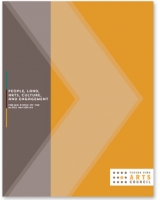People, Land, Arts, Culture, and Engagement: Taking Stock of the PLACE Initiative
GENERAL
With a “paint-by-numbers” template, a muralist invites community members to contribute to a large painting depicting immigrant women held in Arizona detention centers as the participants learn key statistics about detainees and corporate detention systems. A neighborhood holds a festival using music, dancing, and education to promote diabetes awareness and healthy lifestyles. Homeless youth learn from filmmakers how to create videos to ignite action against the systemic causes of youth living on the streets.
All based in Tucson, Arizona, these endeavors are three examples of the dynamic ways the arts can help transform and re-imagine communities, a philosophy that lies at the heart of the PLACE Initiative, a community-based arts initiative of the Tucson Pima Arts Council (TPAC). Since its inception in 2010, PLACE—an acronym for People, Land, Arts, Culture, and Engagement—has provided support for these projects and 50 others by helping individuals and organizations implement arts-based civic engagement projects that address critical community issues.
The PLACE Initiative is fueled by the belief that arts and cultural activities are essential to making meaningful places and can help transform shared spaces into vibrant and nurturing communities. Such activities might include public art, cultural celebrations and festivals, community events that include opportunities for engagement, culturally based civic dialogue, programs that engage youth, traditional arts apprenticeships, heritage practices or other manifestations of “informal” arts, or new forms of community-based arts and culture practices. A particular concern of the PLACE Initiative is advancing tolerance, cross-cultural understanding, and civil society through arts projects focused on engagement and collaboration.
TPAC secured initial funding for the PLACE Initiative from the Kresge Foundation of Troy, Michigan, which pledged to invest $200,000 over two years. This initial funding was part of a pilot program supporting intermediary arts and cultural organizations in mid-sized American cities with high rates of poverty. Kresge identified communities that had long-standing histories of strong community cultural development work and demonstrated they were “shovel ready” to support projects using arts and culture to address contested social issues. The foundation also supported the pilot initiative in St. Louis, Baltimore, Birmingham, and Detroit.
Subsequent funding for PLACE in Tucson came from the Nathan Cummings Foundation ($125,000 over two years) and the Open Society Institute ($150,000 over two years), both New York City organizations that pledged support for projects promoting cultural understanding, diversity, tolerance, and civil society.
Through PLACE, TPAC has funded 53 projects in four rounds of funding from 2010 to 2013. Projects have been undertaken by both small and mid-sized organizations and artists dealing with a wide range of social issues. Some of these issues include statewide concerns such as racial profiling by authorities, overt racial and ethnic intolerance, and other concerns specific to low-income, new-immigrant, and Native American communities as well as to other vulnerable populations such as youth or veterans. Projects have also included place-based and site-spe-cific works addressing themes that come from neighborhood histories, urban development, and Sonoran Desert ecology. Grants range from $1,500 to $10,000.
Recognizing the power of placed-based work and community participation, the PLACE Initiative has enabled activities and projects that involve community partnerships and collaborative efforts, address systemic problems over an extended period of time, and innovate ways of engaging community constituents as essential project collaborators, not solely as audience members. [Introduction, p. 4]
This report serves as a point of entry into creative placemaking as defined and supported by the Tucson Pima Arts Council’s PLACE Initiative. To assess how and to what degree the PLACE projects were helping to transform communities, TPAC was asked by the Kresge Foundation to undertake a comprehensive evaluation. This involved discussion with stakeholders about support mechanisms, professional development, investment, and impact of the PLACE Initiative in Tucson, Arizona, and the Southwest regionally and the gathering of qualitative and quantitative data to develop indicators and method for evaluating the social impact of the arts in TPAC’s grantmaking.
The report documents one year of observations and research by the PLACE research team, outside researchers and reviewers, local and regional working groups, TPAC staff, and TPAC constituency. It considers data from the first four years of PLACE Initiative funding, including learning exchanges, focus groups, individual interviews, grantmaking, and all reporting. It is also informed by evaluation and assessment that occurred in the development of the PLACE Initiative, in particular, Maribel Alvarez’s Two-Way Mirror: Ethnography as a Way to Assess Civic Impact of Arts-Based Engagement in Tucson, Arizona (2009), and Mark Stern and Susan Seifert’s Documenting Civic Engagement: A Plan for the Tucson Pima Arts Council (2009). Both of these publications were supported by Animating Democracy, a program of Americans for the Arts, that promotes arts and culture as potent contributors to community, civic, and social change. Both publications describe how TPAC approaches evaluation strategies associated with social impact of the arts in Tucson and Pima County.
This report outlines the local context and historical antecedents of the PLACE Initiative in the region with an emphasis on the concept of “belonging” as a primary characteristic of PLACE projects and policy. It describes PLACE projects as well as the role of TPAC in creating and facilitating the Initiative. Based on the collective understanding of the research team, impacts of the PLACE Initiative are organized into three main realms—institutions, artists, and communities. These realms are further addressed in case studies from select grantees, whose narratives offer rich, detailed perspectives about PLACE projects in context, with all their successes, rewards, and challenges for artists, communities, and institutions.
BIBLIOGRAPHY






